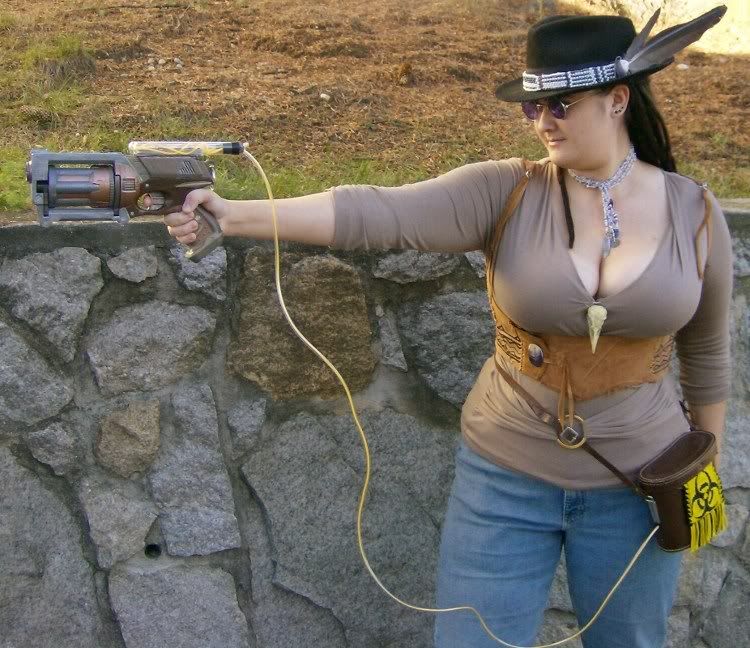Steampunk
#50 Overcoming the Noble Savage & the Sexy Squaw: Native Steampunk
By Monique Poirier
It comes down to mythology, to narrative, and to what stories we’re telling with the personas we portray and how we present them. Some of the attire I own will never be worn outside of a powwow or tribal gathering. For example, I don’t wear prominent feathers–or any feather at all that look like this as part of my Steampunk attire; I treasure the feathers I’ve actually gained through ceremony and ritual too much to wear them to anything less solemn than a powwow or tribe meeting, and I am not comfortable in making mockup feathers that my character/persona would have similarly earned.
It’s pretty grating, then, to be at a convention and having someone comment, “If you’re trying to look like a Native American, you should incorporate more feathers,”‘ because I do understand where that comment comes from. How do you know that an Indian is and Indian if they’re not in the Hollywood Dress Code attire for Indians? A hard and fast rule I’m going by: “If I ran into another member of my tribe while wearing this here, would I feel the need to explain or apologize for it?” If so, I am not wearing that. Even if it means that I’m losing recognition.
There is a vast and predominantly grossly incorrect mythology surrounding Native Americans. Children in American Public Schools, unless they happen to be from an area that has a very prominent and active Native community (and sometimes even then) are generally spoon-fed the tidy and feel-good Story of Thanksgiving as their first lesson in Native American Culture–depending on whether or not they’ve already seen Pocahontas and Peter Pan. They generally graduate to Westerns and various other Hollywood mythologies so that by the time they’re attending cons all on their own they’ve built a distinct expectation of what ‘Native American’ should look like–and if an outfit doesn’t do that, it will not parse as Native American.
Which makes my costuming choices complicated.
Part of the fun of Steampunk is the aspect of alternate history; of deliberate anachronism and the application of alternate timelines and technological developments and the ration of ‘Steam’ to ‘Punk’. It means having the chance to create alternate histories in which Native Americans maintain sociological primacy and control over the North and South American landmass, if we so choose–my own Steampunk persona is an Air Marshall in a timeline in which Tecumseh’s Rebellion was successful and resulted in the creation of a Native American confederacy of nations that holds most of North America, as well as parts of Mexico and several island nations in the Pacific (most notably the Kingdom of Hawaii). She carries a ray gun–and as far as I’m concerned, this is still entirely Native Tech.

Some guidelines on developing a Native steampunk ensemble:
Native American Steampunk--An Approach
By Miss Kagashi
The story of Native Americans in the Age of Steam is one of survival. The peoples of the Plains used every portion of a slain buffalo--not only for spiritual respect of the animal, but common practicality. This mentality becomes even more important post-contact, as game decreases, lands are taken away, and army rations become nothing more than broken promises--so the need to scrounge, scavange, and improvise is dire. Both Western and traditional clothing was worn for necessity--as was the unfortunate and eventual adaptation to firearms and other Western products. This should be reflected in Nativepunk.
Unless you are of Native American descent and understand the reasoning behind it or have received permission from a tribal authority or researcher, do not involve religious or spiritual items in your steampunk. Certain objects and garments hold a lot of power or communicate the status of the wearer such as Plains war bonnets, Plains breastplates, and Woodlands wampum belts. What I'm going to condone is the use of certain garments and decorative styles instead of these items to create your kit. Furthermore do not wear your ensemble to a powwow or Native reenactment, I beg you.
Most important of all: DO YOUR RESEARCH. Each and every tribe is different--so do not assume that if you mix certain stereotypical elements together that you'll have a Nativepunk ensemble. If you don't do your research, not only will you look a mess, but people in the know can and will call you out on it (believe me, I know). Basically, don't be a bad Halloween costume, give these people the respect that their art deserves.
For more on the subject, see Review of The Difference Engine and Steampunk in Colonial America.

5 comments:
"Native American steampunk is post-contact."
Steampunk is not purely historical, so I actually think that there's room to tweak things a little to have pre-Columbian copper tech, etc.
Yeah, steampunk is basically an alternate timeline.
It's just good to see Indians as nerds. If only the mainstream media would realize we're not all stoic warriors or sexy squaws. (Or that stupid Encyclopædia Dramatica article for ever even thinking of associating us with furries!)
"It's just good to see Indians as nerds."
Did Forge in the X-Men pave the way?
Speaking of this... Rob, did any version of "Wild Wild West" have Natives in it?
If there's any franchise ripe for Native steampunk, it's this well-known long-established steampunk western.
I don't doubt that the new version by Ron Moore will.
I didn't see the Wild Wild West movie. I'd say Indians rarely if ever appeared in the TV series.
I wouldn't call Forge a nerd just because he's good with mechanical and electronic things. He's more like an auto mechanic than Urkel, Lisa Simpson, or the Big Bang Theory crew.
Post a Comment